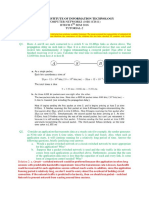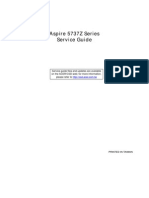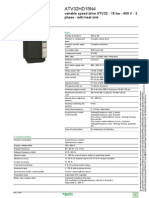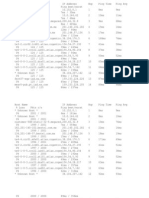Subnetting: Historic Network Classes
Subnetting: Historic Network Classes
Uploaded by
Licio LentimoCopyright:
Available Formats
Subnetting: Historic Network Classes
Subnetting: Historic Network Classes
Uploaded by
Licio LentimoOriginal Description:
Original Title
Copyright
Available Formats
Share this document
Did you find this document useful?
Is this content inappropriate?
Copyright:
Available Formats
Subnetting: Historic Network Classes
Subnetting: Historic Network Classes
Uploaded by
Licio LentimoCopyright:
Available Formats
SUBNETTING
Historic Network Classes Historically, RFC1700 grouped the unicast ranges into specific sizes called class A, class B, and class C addresses. It also defined class D (multicast) and class E (experimental) addresses, as previously presented.
The unicast address classes A, B, and C defined specifically-sized networks as well as specific address blocks for these networks, as shown in the figure. A company or organization was assigned an entire class A, class B, or class C address block. This use of address space is referred to as classful addressing.
Class A Blocks
A class A address block was designed to support extremely large networks with more than 16 million host addresses. Class A IPv4 addresses used a fixed /8 prefix with the first octet to indicate the network address. The remaining three octets were used for host addresses. To reserve address space for the remaining address classes, all class A addresses required that the most significant bit of the high-order octet be a zero. This meant that there were only 128 possible class A networks, 0.0.0.0 /8 to 127.0.0.0 /8, before taking out the reserved address blocks. Even though the class A addresses reserved one-half of the address space, because of their limit of 128 networks, they could only be allocated to approximately 120 companies or organizations.
Class B Blocks
Class B address space was designed to support the needs of moderate to large size networks with more than 65,000 hosts. A class B IP address used the two high-order octets to indicate the network address. The other two octets specified host addresses. As with class A, address space for the remaining address classes needed to be reserved.
For class B addresses, the most significant two bits of the high-order octet were 10. This restricted the address block for class B to 128.0.0.0 /16 to 191.255.0.0 /16. Class B had slightly more efficient allocation of addresses than class A because it equally divided 25% of the total IPv4 address space among approximately 16,000 networks.
Class C Blocks
The class C address space was the most commonly available of the historic address classes. This address space was intended to provide addresses for small networks with a maximum of 254 hosts.
Class C address blocks used a /24 prefix. This meant that a class C network used only the last octet as host addresses with the three high-order octets used to indicate the network address.
Basic Subnetting
Subnetting allows for creating multiple logical networks from a single address block. Since we use a router to connect these networks together, each interface on a router must have a unique network ID. Every node on that link is on the same network.
We create the subnets by using one or more of the host bits as network bits. This is done by extending the mask to borrow some of the bits from the host portion of the address to create additional network bits. The more host bits used, the more subnets that can be defined. For each bit borrowed, we double the number of subnetworks available. For example, if we borrow 1 bit, we can define 2 subnets. If we
borrow 2 bits, we can have 4 subnets. However, with each bit we borrow, fewer host addresses are available per subnet.
RouterA in the figure has two interfaces to interconnect two networks. Given an address block of 192.168.1.0 /24, we will create two subnets. We borrow one bit from the host portion by using a subnet mask of 255.255.255.128, instead of the original 255.255.255.0 mask. The most significant bit in the last octet is used to distinguish between the two subnets. For one of the subnets, this bit is a "0" and for the other subnet this bit is a "1". Formula for calculating subnets
Use this formula to calculate the number of subnets:
2^n where n = the number of bits borrowed
In this example, the calculation looks like this:
2^1 = 2 subnets
The number of hosts
To calculate the number of hosts per network, we use the formula of 2^n - 2 where n = the number of bits left for hosts.
Applying this formula, (2^7 - 2 = 126) shows that each of these subnets can have 126 hosts.
For each subnet, examine the last octet in binary. The values in these octets for the two networks are:
Subnet 1: 00000000 = 0
Subnet 2: 10000000 = 128
See the figure for the addressing scheme for these networks.
Example with 3 subnets
Next, consider an internetwork that requires three subnets. See the figure.
Again we start with the same 192.168.1.0 /24 address block. Borrowing a single bit would only provide two subnets. To provide more networks, we change the subnet mask to 255.255.255.192 and borrow two bits. This will provide four subnets.
Calculate the subnet with this formula:
2^2 = 4 subnets
The number of hosts
To calculate the number of hosts, begin by examining the last octet. Notice these subnets.
Subnet 0: 0 = 00000000
Subnet 1: 64 = 01000000
Subnet 2: 128 = 10000000
Subnet 3: 192 = 11000000
Apply the host calculation formula.
2^6 - 2 = 62 hosts per subnet
See the figure for the addressing scheme for these networks.
Subnetting a subnet
Subnetting a subnet, or using Variable Length Subnet Mask (VLSM) was designed to maximize addressing efficiency. When identifying the total number of hosts using traditional subnetting, we allocate the same number of addresses for each subnet. If all the subnets have the same requirements for the number hosts, these fixed size address blocks would be efficient. However, most often that is not the case.
For example, the topology in Figure 1 shows a subnet requirement of seven subnets, one for each of the four LANs and one for each of the three WANs. With the given address of 192.168.20.0, we need to borrow 3 bits from the host bits in the last octet to meet our subnet requirement of seven subnets.
These bits are borrowed bits by changing the corresponding subnet mask bits to "1s" to indicate that these bits are now being used as network bits. The last octet of the mask is then represented in binary by 11100000, which is 224. The new mask of 255.255.255.224 is represented with the /27 notation to represent a total of 27 bits for the mask.
In binary this subnet mask is represented as: 11111111.11111111.11111111.11100000
After borrowing three of the host bits to use as network bits, this leaves five host bits. These five bits will allow up to 30 hosts per subnet.
Although we have accomplished the task of dividing the network into an adequate number of networks, it was done with a significant waste of unused addresses. For example, only two addresses are needed in each subnet for the WAN links. There are 28 unused addresses in each of the three WAN subnets that have been locked into address these address blocks. Further, this limits future growth by reducing the total number of subnets available. This inefficient use of addresses is characteristic of classful addressing.
Applying a standard subnetting scheme to scenario is not very efficient and is wasteful. In fact, this example is a good model for showing how subnetting a subnet can be used to maximize address utilization.
Getting More Subnet for Less Hosts
Recall in previous examples we began with the original subnets and gained additional, smaller, subnets to use for the WAN links. Creating smaller each subnet is able to support 2 hosts leaves the original subnets free to be allotted to other devices and prevents many addresses from being wasted.
To create these smaller subnets for the WAN links, begin with 192.168.20.192. We can divide this subnet is to many smaller subnets. To provide address blocks for the WANS with two addresses each, we will borrow three additional host bits to be used as network bits.
Address: 192.168.20.192 In Binary: 11000000.10101000.00010100.11000000 Mask: 255.255.255.252 30 Bits in binary: 11111111.11111111.11111111.11111100
The topology in the figure 2 shows an addressing plan that breaks up the 192.168.20.192 /27 subnets into smaller subnets to provide addresses for the WANs. Doing this reduces the number addresses per subnet to a size appropriate for the WANs. With this addressing, we have subnets 4, 5, and 7 available for future networks, as well as several other subnets available for WANs.
You might also like
- Computer Network Imp QuestionsDocument4 pagesComputer Network Imp QuestionsziddirazanNo ratings yet
- Variable Length Arguments ( Args), Keyword Varargs ( Kwargs) in PythonDocument12 pagesVariable Length Arguments ( Args), Keyword Varargs ( Kwargs) in PythonAk KumarNo ratings yet
- Module 2 - Basics of CDocument6 pagesModule 2 - Basics of CSt. Martin ChoirNo ratings yet
- Introduction To C ProgrammingDocument47 pagesIntroduction To C ProgrammingramindercheemaNo ratings yet
- IPAddressDocument33 pagesIPAddressBrij ChaudharyNo ratings yet
- C Code To Implement RSA AlgorithmDocument13 pagesC Code To Implement RSA AlgorithmharineeNo ratings yet
- Medium Access ControlDocument10 pagesMedium Access ControlVijay ParuchuriNo ratings yet
- CN Unit-1 MaterialDocument21 pagesCN Unit-1 Materialabinayaa.sNo ratings yet
- Introduction To Communications: Channel CodingDocument27 pagesIntroduction To Communications: Channel CodingHarshaNo ratings yet
- Chap3. CoAPDocument27 pagesChap3. CoAPeka fujiNo ratings yet
- Adaptive and Secure Routing Protocol For Emergency Mobile Ad Hoc NetworksDocument17 pagesAdaptive and Secure Routing Protocol For Emergency Mobile Ad Hoc NetworksJohn BergNo ratings yet
- Socket PresentationDocument13 pagesSocket PresentationYogananda PatnaikNo ratings yet
- Advanced Bash Scripting GuideDocument907 pagesAdvanced Bash Scripting GuideHaoyuan LiuNo ratings yet
- CCNA Security 04Document121 pagesCCNA Security 04mcvaldebenitoNo ratings yet
- Transport Layer ServicesDocument71 pagesTransport Layer ServicesSomnath Sinha100% (1)
- 1) Classful Addressing: Classes and BlocksDocument7 pages1) Classful Addressing: Classes and BlockssureshgurujiNo ratings yet
- CN Unit1 8-7-10Document20 pagesCN Unit1 8-7-10nallapatiharika0% (1)
- ITE I Networking FundamentalsDocument64 pagesITE I Networking Fundamentalsapi-3722006No ratings yet
- Network LayerDocument66 pagesNetwork LayerEatus AspiritusNo ratings yet
- CH2 6TISCH Adaptation LayerDocument9 pagesCH2 6TISCH Adaptation LayerSakata GintokiNo ratings yet
- Chapter 1 - Computer Network OverviewDocument36 pagesChapter 1 - Computer Network OverviewGENENE TISENo ratings yet
- 312 50v9Document34 pages312 50v9Vasil SultanovNo ratings yet
- Data Communication Lecture NoteDocument116 pagesData Communication Lecture Notelovet essampongNo ratings yet
- Unit-1 Web EssentialsDocument6 pagesUnit-1 Web EssentialsBir MallaNo ratings yet
- FirewallDocument13 pagesFirewallPrakash VarmaNo ratings yet
- ADS Chapter 4 Concurrency Control TechniquesDocument36 pagesADS Chapter 4 Concurrency Control Techniquesdag mawiNo ratings yet
- Computer Networks and The InternetDocument35 pagesComputer Networks and The InternetMohammedAbuHussein100% (1)
- IT2910 Midterm Study Guide SP2013Document27 pagesIT2910 Midterm Study Guide SP2013John TanNo ratings yet
- Computer Networks Lab Manual: V SemesterDocument53 pagesComputer Networks Lab Manual: V SemesterGanesanDhandapaniNo ratings yet
- Jaypee Institute of Information Technology: Computer Networks (10B11Ci611) Btech 6 SEM 2016 Tutorial-2Document9 pagesJaypee Institute of Information Technology: Computer Networks (10B11Ci611) Btech 6 SEM 2016 Tutorial-2Anubhav MishraNo ratings yet
- Source Port: 16 Bits: TCP Header FormatDocument6 pagesSource Port: 16 Bits: TCP Header Format254186No ratings yet
- CCN NOTS Final Unit - 3Document39 pagesCCN NOTS Final Unit - 3Bruce Randall100% (3)
- Unicast Routing - MukeshDocument29 pagesUnicast Routing - MukeshMukeshNo ratings yet
- Huawei Training Day 1 NotesDocument28 pagesHuawei Training Day 1 NotesMutumaNo ratings yet
- Telecom Principles GOSDocument30 pagesTelecom Principles GOSmoshesas100% (1)
- Advance Computer NetworkDocument7 pagesAdvance Computer NetworkHIRAL AMARNATH YADAVNo ratings yet
- Transport Layer - MukeshDocument54 pagesTransport Layer - MukeshMukeshNo ratings yet
- Data Link Layer - Computer NetworksDocument102 pagesData Link Layer - Computer NetworksShivasai NampellyNo ratings yet
- CS 601 Data Communication Latest File Spring 2021Document111 pagesCS 601 Data Communication Latest File Spring 2021mc210202582 MUEEN HASANNo ratings yet
- Classsical Encryption Techniques MukeshDocument13 pagesClasssical Encryption Techniques MukeshMukeshNo ratings yet
- Documentation v.2.5 OPENSTAKDocument20 pagesDocumentation v.2.5 OPENSTAKBnaren NarenNo ratings yet
- Solutions MidtermDocument10 pagesSolutions MidtermVineet RawatNo ratings yet
- Unit-Iii: (Q) Explain Network Layer Design Issues? (2M/5M)Document28 pagesUnit-Iii: (Q) Explain Network Layer Design Issues? (2M/5M)karthik vaddiNo ratings yet
- ZigbeeDocument56 pagesZigbeekumgganeshNo ratings yet
- ProjectDocument27 pagesProjectPratap VeerNo ratings yet
- 5-Network Access ControlDocument34 pages5-Network Access ControlQosai ZoubiNo ratings yet
- ch12 Crypto and Network SecurityDocument34 pagesch12 Crypto and Network SecurityImam FadhilNo ratings yet
- 28 Hw5-SolDocument18 pages28 Hw5-Solkisibongdem1412No ratings yet
- Distributed Systems-A Brief IntroductionDocument30 pagesDistributed Systems-A Brief IntroductionkhoadplaNo ratings yet
- Adi ss7Document29 pagesAdi ss7adityamishra244100% (4)
- Network ProtocolsDocument20 pagesNetwork ProtocolsKamesh SjNo ratings yet
- Module - 1 Notes: Transport Level Security: Web Security Considerations, Secure Sockets Layer, TransportDocument45 pagesModule - 1 Notes: Transport Level Security: Web Security Considerations, Secure Sockets Layer, Transportrushil prasadNo ratings yet
- Network Layer AssignmentDocument3 pagesNetwork Layer AssignmentAnuraagKashyapNo ratings yet
- Network Layer - IP - MukeshDocument19 pagesNetwork Layer - IP - MukeshMukesh100% (2)
- IPv 6Document68 pagesIPv 6Diether SantosNo ratings yet
- William Stallings, Cryptography and Network Security 6 - e (PDFDrive)Document65 pagesWilliam Stallings, Cryptography and Network Security 6 - e (PDFDrive)renohe9897No ratings yet
- Comnputer and Network Security NEW 3350704Document8 pagesComnputer and Network Security NEW 3350704shyjuother9773No ratings yet
- Performance Analysis of RIP, EIGRP, OSPF and ISIS Routing ProtocolsDocument8 pagesPerformance Analysis of RIP, EIGRP, OSPF and ISIS Routing ProtocolsLee HeaverNo ratings yet
- Handbook of Mobile Application Development: A Guide to Selecting the Right Engineering and Quality FeaturesFrom EverandHandbook of Mobile Application Development: A Guide to Selecting the Right Engineering and Quality FeaturesNo ratings yet
- IP Addressing: ClassesDocument6 pagesIP Addressing: ClassesQaid Saleh AledresiNo ratings yet
- Management Information SystemsDocument87 pagesManagement Information SystemsLicio Lentimo100% (1)
- Transactions in DatabasesDocument12 pagesTransactions in DatabasesLicio LentimoNo ratings yet
- Website Design ProposalDocument11 pagesWebsite Design ProposalLicio Lentimo100% (1)
- Breast Cancer TreatmentDocument3 pagesBreast Cancer TreatmentLicio LentimoNo ratings yet
- A Twenty Hour NightmareDocument3 pagesA Twenty Hour NightmareLicio LentimoNo ratings yet
- Prostate Cancer: Signs and SymptomsDocument5 pagesProstate Cancer: Signs and SymptomsLicio LentimoNo ratings yet
- Patek PhilippeDocument2 pagesPatek PhilippeLicio Lentimo100% (1)
- The Spleen: These Four Components AreDocument1 pageThe Spleen: These Four Components AreLicio LentimoNo ratings yet
- World's Most Expensive ParliamentDocument1 pageWorld's Most Expensive ParliamentLicio LentimoNo ratings yet
- Cervical CancerDocument2 pagesCervical CancerLicio LentimoNo ratings yet
- The Sydney Opera HouseDocument1 pageThe Sydney Opera HouseLicio LentimoNo ratings yet
- Diabetes Mellitus Type 2Document3 pagesDiabetes Mellitus Type 2Licio LentimoNo ratings yet
- 208805aq So Vcloud Guide SD Wan NFV VFN Uslet WebDocument6 pages208805aq So Vcloud Guide SD Wan NFV VFN Uslet WebmeetsudharNo ratings yet
- Chapter-1 Introduction To CNDocument88 pagesChapter-1 Introduction To CNRajit ShettyNo ratings yet
- Price Modules GSMDocument73 pagesPrice Modules GSMHemanath ViswanathanNo ratings yet
- Internet of Things (IOT) : Technology and Applications: Dr. Mazlan Abbas MIMOS BerhadDocument54 pagesInternet of Things (IOT) : Technology and Applications: Dr. Mazlan Abbas MIMOS BerhadmeenakshiNo ratings yet
- Fortigate CookThe FortiGate Cookbook 5.2Document512 pagesFortigate CookThe FortiGate Cookbook 5.2Jociano BaumNo ratings yet
- Product Data Sheet AMS Trex Device CommunicatorDocument9 pagesProduct Data Sheet AMS Trex Device CommunicatorSardar PerdawoodNo ratings yet
- Katalog Nastroju Frezovani EngDocument318 pagesKatalog Nastroju Frezovani EngRajesh RameswaranNo ratings yet
- Cpri Mux (Sran18.1 - Draft A)Document99 pagesCpri Mux (Sran18.1 - Draft A)VVLNo ratings yet
- Bni Eip-508-105-Z015 - enDocument29 pagesBni Eip-508-105-Z015 - enDeath528No ratings yet
- Tfa Collector Do CV 121260Document67 pagesTfa Collector Do CV 121260Sujeewa Chathurani DiasNo ratings yet
- Acer Aspire 5737Z Service-ManualDocument188 pagesAcer Aspire 5737Z Service-ManualGuilherme MartinsNo ratings yet
- Ccna 3 CheatsheetDocument3 pagesCcna 3 CheatsheetLuciana NeaguNo ratings yet
- Android Hacking in Kali Linux Using Metasploit FraDocument8 pagesAndroid Hacking in Kali Linux Using Metasploit FramalikaleNo ratings yet
- Waf Fle 0.6.3 Deployment GuideDocument43 pagesWaf Fle 0.6.3 Deployment GuideanhphuongNo ratings yet
- LG 47la640s PDFDocument128 pagesLG 47la640s PDFDoru Darius0% (1)
- Guidelines For Testing Computer Systems and Network: Quarter 2-Week 5 ModuleDocument6 pagesGuidelines For Testing Computer Systems and Network: Quarter 2-Week 5 ModuleReicy Mae TrinidadNo ratings yet
- MB 3 2 PDFDocument378 pagesMB 3 2 PDFSaikat DasNo ratings yet
- HUAWEI - HG8010H - DatasheetDocument2 pagesHUAWEI - HG8010H - DatasheetHernan MansillaNo ratings yet
- Performance Analysis of 5G Network Based On BDMA and Massive - MIMODocument9 pagesPerformance Analysis of 5G Network Based On BDMA and Massive - MIMOIJRASETPublicationsNo ratings yet
- Licensing ModelDocument29 pagesLicensing ModelsmaikolNo ratings yet
- 5G Architecture Model & Concepts PDF (2019)Document108 pages5G Architecture Model & Concepts PDF (2019)Martial CoffiNo ratings yet
- CloudEngine S5735-L-I Series Extended-Temperature Switches DatasheetDocument20 pagesCloudEngine S5735-L-I Series Extended-Temperature Switches DatasheetDuncan Ngacha GitauNo ratings yet
- 74SCSDocument141 pages74SCSAsif BelalNo ratings yet
- ICT Grade 11 Unit 4: 4.1. Advanced SearchingDocument5 pagesICT Grade 11 Unit 4: 4.1. Advanced SearchingYeneneh100% (1)
- Iso Iec 14443 4 2018Document15 pagesIso Iec 14443 4 2018linxm8640No ratings yet
- FortiNAC Local RADIUS Server v9Document16 pagesFortiNAC Local RADIUS Server v9amanjeetkumarmishra63No ratings yet
- ATV32HD15N4Document12 pagesATV32HD15N4gasm22No ratings yet
- CMS Video Monitor Platform User ManualDocument32 pagesCMS Video Monitor Platform User ManualAlexander Blanco GarciaNo ratings yet
- Four Layers of TCP/IP Model Explained: Difference Between TCP/IP and OSI ModelDocument3 pagesFour Layers of TCP/IP Model Explained: Difference Between TCP/IP and OSI Modelsundar anandanNo ratings yet
- Uotrace 20 MayDocument2 pagesUotrace 20 MayJnt MFNo ratings yet





































































































